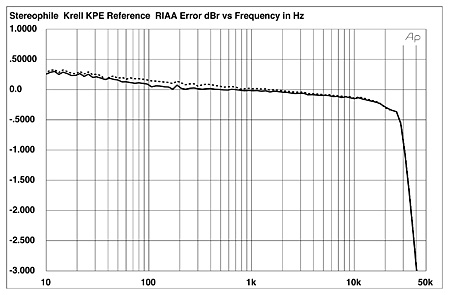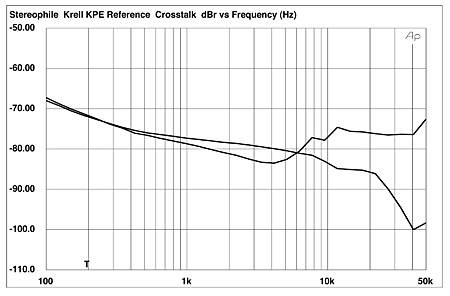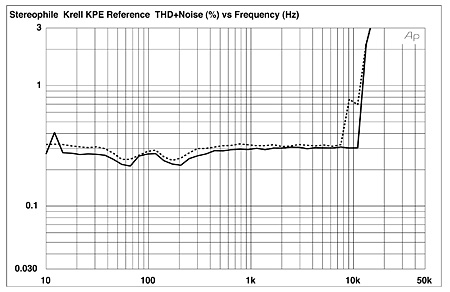| Columns Retired Columns & Blogs |
Krell KPE & KPE Reference phono preamplifiers Reference Measurements
Sidebar 4: Reference Measurements
The internal KPE Reference board was measured with the phono impedance and gain settings used by WP in his review. (All phono measurements were taken at the KRC-HR's tape outputs, as is our normal practice.) The phono input impedance measured just under 126 ohms and the unit was noninverting from the phono inputs to the tape outputs. Voltage gain measured 66.8dB at 1kHz. The S/N readings were 62.5dB (unweighted, 22Hz–22kHz), 55dB (unweighted, 10Hz–500kHz), and 73.9dB (A-weighted), these all excellent. Reducing the voltage gain to the 58dB gain setting gave improved S/N Ratios of 76dB (22Hz–22kHz), 65dB (10Hz–500kHz), and 86.5dB (A-weighted).
The RIAA error (fig.1) is within ±0.3dB from 20Hz to 20kHz; the downward tilt of the response will probably be audible as a subtly warm sound on phono, everything else being equal. Of course, it never is, and since many moving-coil cartridges show an upward tilt at the top end, the KPE's small RIAA deviation will probably be more than overridden by the response of the cartridge.

Fig.1 Krell KPE Reference, RIAA error at 2.9mV input at 1kHz into 100k ohms (0.5dB/vertical div.).
The Krell KPE's crosstalk is shown in fig.2 and is rather unusual in that the usual increase in crosstalk at higher frequencies is minimal in one channel and decreasing, instead, in the other. Channel separation is still excellent, however. As is our usual practice for this measurement, I kept the input levels high here to override the effects of noise. The same is true of the THD+noise vs frequency plot shown in fig.3. The increase in distortion in the phono curve at high frequencies is likely due to this relatively high input level (2.9mV at 1kHz in this case—the typical moving-coil output is closer to 0.5mV at 1kHz).

Fig.2 Krell KPE Reference, channel separation (from top to bottom): L–R, R–L (10dB/vertical div.).

Fig.3 Krell KPE Reference, THD+noise vs frequency at 2.9mV at 1kHz into 100k ohms.
Finally, the Krell's phono overload margin (defined as 1% THD+noise) of the was not particularly high: 3.16mV at 1kHz (16dB), 14.4mV at 20kHz (9.2dB), and 0.35mV at 20Hz (16.9dB). The input signal used for the latter measurements was unequalized and the variation with overload margin with frequency is due to the characteristics of the RIAA curve. Since we were dealing with a very high overall voltage gain, I rechecked these measurements using the 58dB gain setting (measured gain here was 55.3dB at 1kHz). In this configuration, I measured the 1% THD+noise point for the phono stage at 12.1mV at 1kHz (27.7dB), 14.3mV at 20kHz (9.1dB), and 1.345 mV at 20Hz (28.6dB). Other than at 20kHz, this is much better performance. However, the less-good margins at the 70dB setting would not have been a problem with the low output MC used by WP for his auditioning.—Thomas J. Norton
- Log in or register to post comments




































